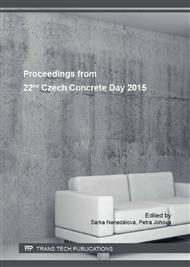p.253
p.261
p.267
p.273
p.278
p.284
p.290
p.296
p.301
Influence of Static and Dynamic Loads on the Behavior of Prestressed Concrete Railway Sleepers
Abstract:
Various types of sleepers from different materials are used in railroad tracks, therefore nowadays prestressed concrete sleepers are the most common type of sleepers. High strength concrete and prestressing reinforcement are used in concrete sleepers. These railroad members are stiff, durable and can withstand heavy loads. However replacement of the cracked or damaged sleepers are expensive and it is necessary to properly design and test them before exploitation. Experimental research of prestressed concrete sleepers under static and dynamic loads are described in this article. Sleeper rail seat section is a support for the rails and various types of heavy loads are affecting this part of the sleeper. Therefore analysis of experimental results on sleeper rail seat bearing capacity and cracking are provided. Sleepers must meet certain cracking requirements and residual crack width must not exceed design value. Experimental residual crack widths are compared with design values. Influence of different diameter and strength reinforcement is analyzed on the behaviour of sleeper rail seat section.
Info:
Periodical:
Pages:
278-283
Citation:
Online since:
April 2016
Authors:
Keywords:
Price:
Сopyright:
© 2016 Trans Tech Publications Ltd. All Rights Reserved
Share:
Citation:


